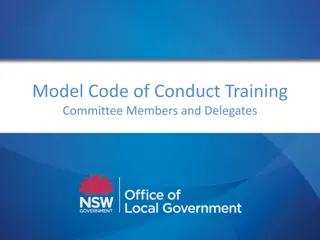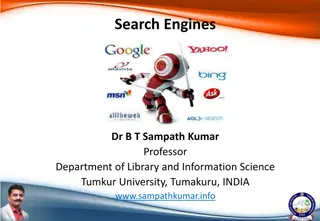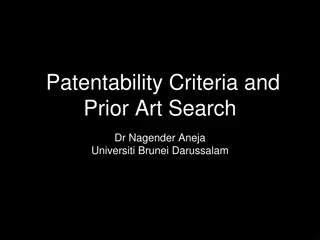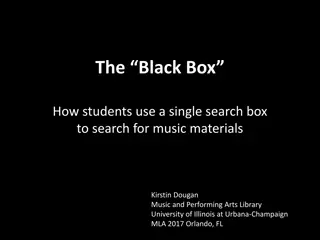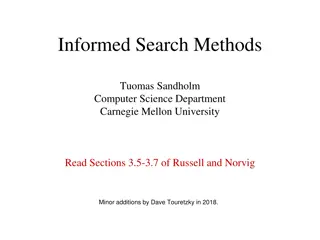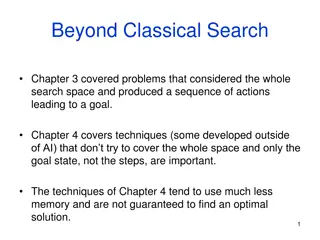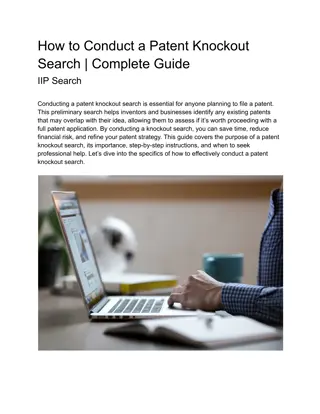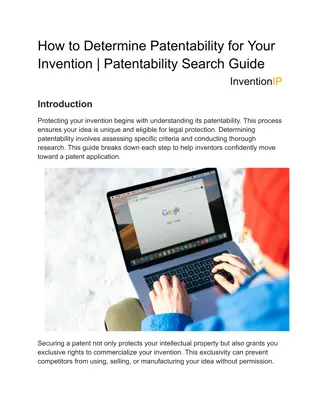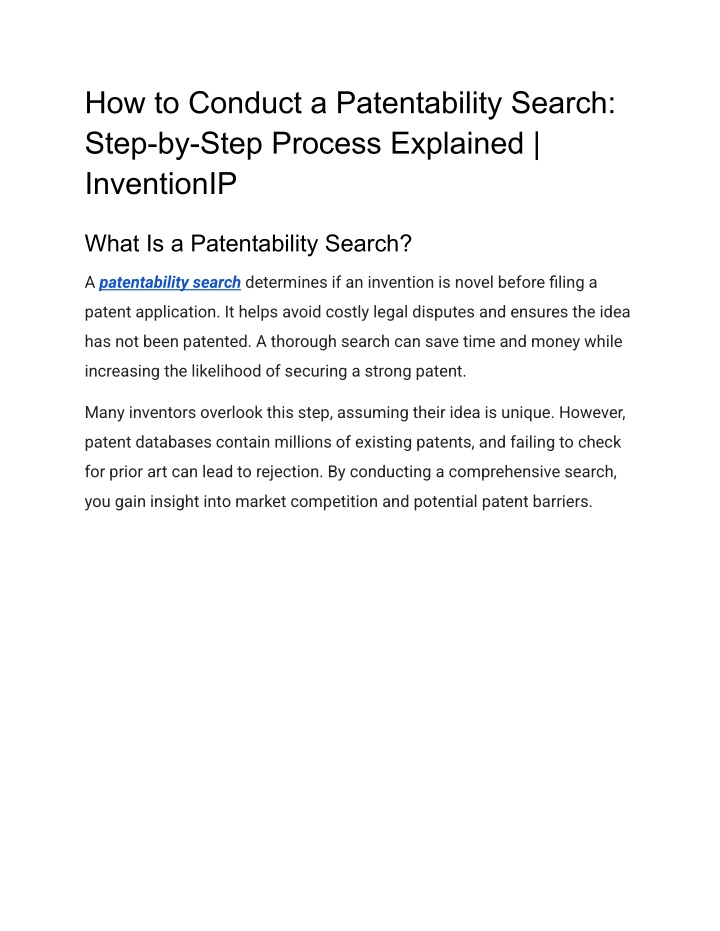
How to Conduct a Patentability Search: A Step-by-Step Guide | InventionIP
Conducting a patentability search is essential before filing a patent to ensure your invention is truly novel. This step-by-step guide walks you through identifying relevant keywords, searching patent databases like USPTO and WIPO, analyzing prior ar
Uploaded on | 1 Views
Download Presentation

Please find below an Image/Link to download the presentation.
The content on the website is provided AS IS for your information and personal use only. It may not be sold, licensed, or shared on other websites without obtaining consent from the author. If you encounter any issues during the download, it is possible that the publisher has removed the file from their server.
You are allowed to download the files provided on this website for personal or commercial use, subject to the condition that they are used lawfully. All files are the property of their respective owners.
The content on the website is provided AS IS for your information and personal use only. It may not be sold, licensed, or shared on other websites without obtaining consent from the author.
E N D
Presentation Transcript
How to Conduct a Patentability Search: Step-by-Step Process Explained | InventionIP What Is a Patentability Search? A patentability search determines if an invention is novel before filing a patent application. It helps avoid costly legal disputes and ensures the idea has not been patented. A thorough search can save time and money while increasing the likelihood of securing a strong patent. Many inventors overlook this step, assuming their idea is unique. However, patent databases contain millions of existing patents, and failing to check for prior art can lead to rejection. By conducting a comprehensive search, you gain insight into market competition and potential patent barriers.
Step 1: Understand Your Invention Before searching, define the invention s key aspects. Identify its unique features, technical specifications, and potential applications. Think about how your invention solves a problem differently than existing solutions.
To clarify your idea, write a detailed description of the invention. Highlight its core components and functions. This will help in keyword selection and search refinement. Step 2: Identify Relevant Keywords Use synonyms, technical terms, and industry-specific jargon to expand search results. Utilize Boolean operators like AND, OR, and NOT for precise searches. Keywords play a crucial role in retrieving relevant patents and prior art. For example, if you re inventing a wireless charging pad, consider keywords like cordless charger, inductive charging station, or electromagnetic charging device. Brainstorm variations to maximize search effectiveness. Step 3: Search Patent Databases Check official patent databases like: USPTO (United States Patent and Trademark Office) EPO (European Patent Office) WIPO (World Intellectual Property Organization) Google Patents PATENTSCOPE CNIPA (China National Intellectual Property Administration)
JPO (Japan Patent Office) Each database provides extensive archives of granted and pending patents. Searching multiple sources ensures comprehensive results. Different countries have different patent laws, so checking international databases broadens your search scope. Step 4: Review Patent Classifications Patent offices categorize inventions under specific classification codes. Use these codes to refine searches and find similar patents efficiently. The Cooperative Patent Classification (CPC) system and International Patent Classification (IPC) are commonly used worldwide. Understanding these classifications helps in targeting specific technological fields. For example, solar-powered batteries may fall under different classes related to energy storage and renewable energy. Step 5: Analyze Prior Art Prior art includes existing patents, published applications, scientific journals, and technical documents. Compare them with your invention to assess novelty. If your invention already exists, you may need to innovate further or focus on a different aspect. Case Study: Apple vs. Samsung Patent Dispute One of the most famous patent battles occurred between Apple and Samsung. Apple accused Samsung of infringing on multiple design and
utility patents related to smartphone features. This dispute highlighted the importance of conducting comprehensive patent searches before product launches. By studying prior art, companies can avoid legal conflicts and improve their inventions before filing applications. Step 6: Examine Non-Patent Literature Research industry white papers, product manuals, research papers, and other non-patent literature. These can reveal whether your idea is already in the public domain. Some groundbreaking ideas are published in scientific journals but never patented. Step 7: Verify Legal Status Even if a patent exists, check if it is expired or abandoned. Expired patents can sometimes be used freely. Reviewing legal status helps determine whether a patent blocks your innovation. Expired patents can provide inspiration for new developments. Many technologies fall into the public domain after a patent expires, allowing other inventors to improve or repurpose them. Step 8: Document Findings Maintain a detailed record of your search results, including relevant patents and prior art references. This information is valuable for refining the
invention and preparing a strong patent application. Keep notes on how your invention differs from existing solutions. Creating a spreadsheet with links to patents, summaries, and comparisons can be helpful. This makes it easier to explain novelty when drafting a patent application. Step 9: Seek Professional Assistance Patent attorneys or professional search firms can conduct a thorough search and interpret legal aspects effectively. Their expertise minimizes risks in patent applications. Experts can also help determine whether modifications to your invention can enhance its patentability. Example: The Edison Light Bulb Patent Battle Thomas Edison is credited with inventing the light bulb, but his patent was challenged by earlier inventors. His legal team had to prove that his version was novel and non-obvious. This underscores the importance of thorough searches and strong patent applications. Step 10: Decide on the Next Steps If the invention is patentable, proceed with filing a patent application. If similar patents exist, consider modifying the invention or exploring other protection strategies like trade secrets or design patents.
In some cases, inventors choose to license existing patents instead of filing new applications. This can be a cost-effective way to bring an idea to market. Common Mistakes to Avoid 1.Relying on a Single Database Always search multiple sources for a complete picture. 2.Ignoring Non-Patent Literature Innovation exists outside patent databases. 3.Failing to Use Advanced Search Techniques Boolean operators and classifications improve accuracy. 4.Not Consulting a Professional Legal expertise ensures a more effective strategy. 5.Skipping Legal Status Checks Some patents may be expired or unenforceable. FAQs About Patentability Searches 1. How long does a patentability search take? It depends on the complexity of the invention. A basic search can take a few hours, while a detailed professional search may take weeks.
2. Can I conduct a patent search myself? Yes, but professional assistance increases accuracy. Patent attorneys have access to specialized tools and legal expertise. 3. What happens if my invention is already patented? You may need to modify the invention or explore licensing options with the patent holder. 4. How much does a professional patentability search cost? Costs vary but generally range from $300 to $3,000, depending on the scope of the search and expertise of the provider. 5. Is a patent search legally required? No, but it is strongly recommended to avoid infringement risks and unnecessary expenses. 6. What if my idea is novel but similar to existing patents? You may still obtain a patent if your invention has unique and non-obvious improvements over prior art. Final Thoughts A well-executed patentability search saves time, money, and effort. It ensures that an invention meets the novelty requirement before investing in a patent application. Following these steps enhances the chances of
securing patent protection successfully. Taking a proactive approach to intellectual property protection strengthens your competitive edge. Need a Professional Patentability Search? Conducting a thorough patent search can be challenging. If you need expert assistance, visit Invention IP for professional patentability search services. Get accurate results and protect your innovation today!




